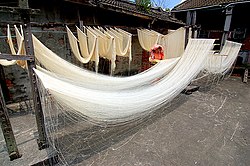Noodle

|
|
| Type | Noodle |
|---|---|
| Main ingredients | Unleavened dough |
| Variations | Numerous |
| |
|
Noodles are a staple food in many cultures made from unleavened dough which is stretched, extruded, or rolled flat and cut into one of a variety of shapes. While long, thin strips may be the most common, many varieties of noodles are cut into waves, helices, tubes, strings, or shells, or folded over, or cut into other shapes. Noodles are usually cooked in boiling water, sometimes with cooking oil or salt added. They are often pan-fried or deep-fried. Noodles are often served with an accompanying sauce or in a soup. Noodles can be refrigerated for short-term storage, or dried and stored for future use. The material composition or geocultural origin must be specified when discussing noodles. The word derives from the German word Nudel.
The origin of noodles has been disputed, but the evidence heavily favors its origin in China. Claims have been made that the noodle was of Chinese, Arabian and Mediterranean origin. A Nature article claimed the oldest evidence of noodle consumption was from 4,000 years ago in China. In 2005, a team of archaeologists working in the People's Republic of China reported finding an earthenware bowl that contained foxtail millet and broomcorn millet noodles at the Lajia archaeological site, arguably hailing from the late neolithic period, but this claim was disputed by later research, which suggested that noodles simply cannot be produced from millet, which lacks gluten.
The earliest written record of noodles is found in a book dated to the Eastern Han period (25–220). Noodles, often made from wheat dough, became a staple food for people of the Han Dynasty (206 BCE - 220 CE). During the Tang Dynasty, the noodles were first cut into strips, and in the Yuan Dynasty the making of dried noodles began.
Wheat noodles in Japan (udon) were adapted from a Chinese recipe by a Buddhist monk as early as the 9th century. Reshteh noodles were eaten by the people of Persia by the 13th century. Innovations continued, as for example, noodles made from buckwheat (naengmyeon) were developed in the Joseon Dynasty of Korea (1392–1897). Ramen noodles, based on Chinese noodles, became popular in Japan by 1900.
...
Wikipedia
